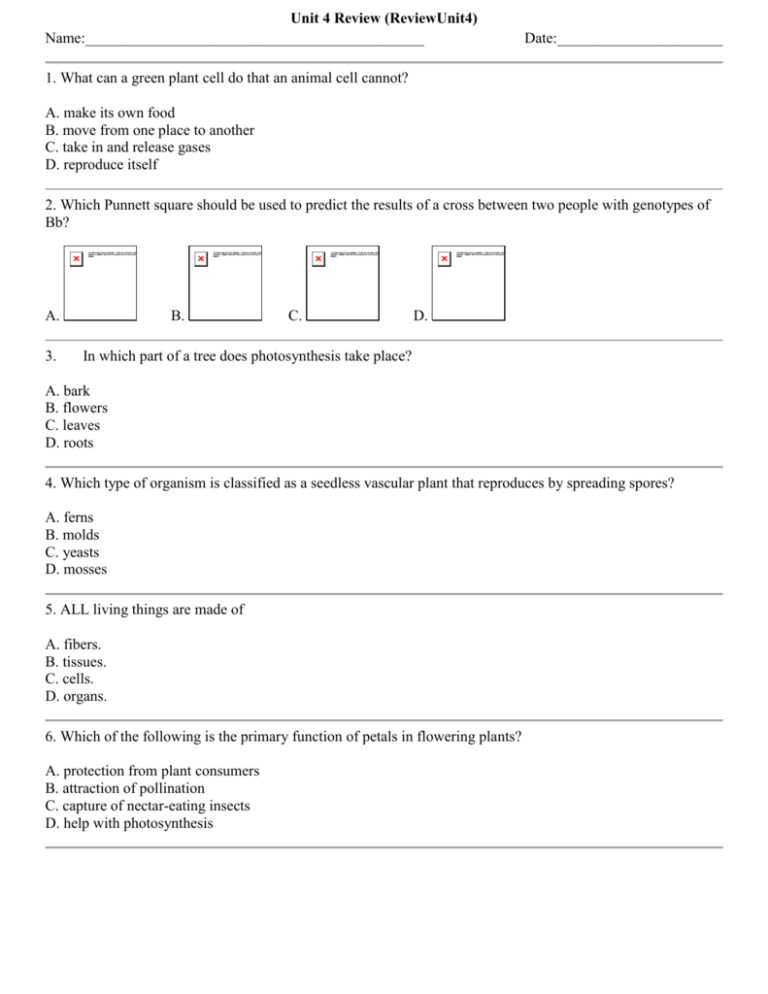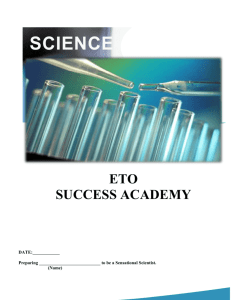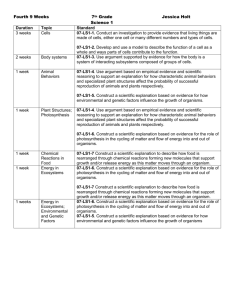Unit 4 Review (ReviewUnit4)
advertisement

Unit 4 Review (ReviewUnit4) Name:_____________________________________________ Date:______________________ 1. What can a green plant cell do that an animal cell cannot? A. make its own food B. move from one place to another C. take in and release gases D. reproduce itself 2. Which Punnett square should be used to predict the results of a cross between two people with genotypes of Bb? A. 3. B. C. D. In which part of a tree does photosynthesis take place? A. bark B. flowers C. leaves D. roots 4. Which type of organism is classified as a seedless vascular plant that reproduces by spreading spores? A. ferns B. molds C. yeasts D. mosses 5. ALL living things are made of A. fibers. B. tissues. C. cells. D. organs. 6. Which of the following is the primary function of petals in flowering plants? A. protection from plant consumers B. attraction of pollination C. capture of nectar-eating insects D. help with photosynthesis 7. Nonvascular plants include A. mosses and algae. B. liverworts and fungi. C. algae and fungi. D. liverworts and mosses. 8. Flowering plants are also known as A. echinosperms. B. gymnosperms. C. angiosperms. D. seed ferns. 9. On a recent research trip to the African rain forest, Donna discovered a new organism that is multicellular and contains chlorophyll. Which kingdom does the newly discovered organism most likely belong to? A. Animals B. Plants C. Monerans D. Fungi 10. George's science class looked at living cells under a microscope. The students studied an organism that had many different kinds of cells, but each cell had a cell wall and nucleus. To which kingdom did this organism belong? A. Animals B. Protists C. Monerans D. Plants 11. Brown eyes are dominant to blue eyes. Both of Donna's parents have brown eyes, but Donna has blue eyes. What is the BEST explanation for why Donna has blue eyes? A. All of Donna's grandparents must have had blue eyes. B. Both of Donna's parents carry a gene for blue eyes. C. Donna's mother probably carries the gene for blue eyes. D. Donna's father probably carries the gene for blue eyes. 12. Mike and his three brothers all have brown hair. Mike's father has brown hair, too. Mike's mother, however, is the only family member that has red hair color. What conclusion can you draw about the gene for hair color? A. The gene for red hair is dominant over the gene for brown hair. B. The gene for brown hair is dominant over the gene for red hair. C. Neither brown nor red are dominant since they both occur in the same family. D. Red and brown genes are co-dominant. 13. Rudy has blue eyes, while Gertrude has brown eyes. What causes them to have different eye colors? A. They have different chromosomes for the two eye colors. B. Rudy has a different number of chromosomes than Gertrude. C. They have different combinations of the genes for eye color. D. Rudy's mother must have had blue eyes, because you only get blue eyes from your mother. 14. What type of cell MUST take up carbon dioxide in order to stay alive? A. plant cell B. animal cell C. fungal cell D. yeast cell 15. In pea plants, purple flowers are dominant to white flowers. Suppose a purple-flowered plant with genotype Pp is crossed with another purple-flowered plant with the same Pp genotype. What percentage of offspring will also have purple flowers? A. 25% B. 50% C. 75% D. 100% 16. The allele for black hair, B, is dominant to orange tabby color, b, in cats. Based upon the Punnett square shown above, what did the parents look like in this genetic cross? A. two tabby parents B. two black parents C. one black parent, one tabby parent D. both parents were a mix of black and tabby 17. In plant cells, chloroplasts — A. act as the cell's control center. B. enable plant cells to produce their own food. C. allow materials to move into and out of the cell. D. support and protect the cell. 18. Certain species of orchids have flowers that look like female bees. This provides an advantage to the orchids by A. helping to trap moisture. B. attracting male bees to transfer pollen. C. discouraging flies from landing on the flowers. D. attracting birds that eat the flowers. 19. Photosynthesis is the way plants make food. Which of the following are always needed for photosynthesis? A. water, light, chlorophyll, carbon dioxide B. water, light, flowers, oxygen C. water, roots, stems, leaves D. water, light, fertilizer, oxygen 20. The process in which green plants convert energy from the Sun into energy stored in carbon-containing molecules is called A. respiration. B. combustion. C. digestion. D. photosynthesis. 21. Oxygen is released into the air by A. the Sun. B. animals. C. volcanoes. D. plants. 22. During photosynthesis, green plants remove a substance from the air. The substance is A. water. B. oxygen. C. sulfur dioxide. D. carbon dioxide. 23. In the presence of sunlight green plants give off A. oxygen. B. carbon dioxide. C. nitrogen. D. hydrogen. 24. Plants with spines and waxy leaves are well-suited for life in which environment? A. temperate forest B. grassland C. tropical forest D. desert 25. The process by which producers make their own food is called A. diffusion. B. photosynthesis. C. respiration. D. reproduction. 26. Photosynthesis in green plants requires four things. Three of the requirements are water, chlorophyll, and carbon dioxide. What is the fourth requirement? A. soil B. rain C. light D. fertilizer 27. What is the original source of energy for the organisms in the picture below? A. grass B. mouse C. water D. sunlight 28. Autotrophs are organisms that produce their own food. Which do scientists classify as autotrophs? A. chordates B. fungi C. plants D. molds 29. Plants and other producers use sunlight for photosynthesis. What do plants make during photosynthesis? A. water B. sugars C. protein D. carbon dioxide 30. Which of the following correctly lists the organizational hierarchy of organisms from simplest to most complex? A. cells, organs, tissues, organ systems, organisms B. cells, tissues, organs, organ systems, organisms C. tissues, cells, organs, organ systems, organisms D. tissues, organs, cells, organ systems, organisms . Answer Key 1. A) make its own food 2. D) 3. C) leaves 4. A) ferns 5. C) cells. 6. B) attraction of pollination 7. D) liverworts and mosses. 8. C) angiosperms. 9. B) Plants 10. D) Plants 11. B) Both of Donna's parents carry a gene for blue eyes. 12. B) The gene for brown hair is dominant over the gene for red hair. 13. C) They have different combinations of the genes for eye color. 14. A) plant cell 15. C) 75% 16. C) one black parent, one tabby parent 17. B) enable plant cells to produce their own food. 18. B) attracting male bees to transfer pollen. 19. A) water, light, chlorophyll, carbon dioxide 20. D) photosynthesis. 21. D) plants. 22. D) carbon dioxide. 23. A) oxygen. 24. D) desert 25. B) photosynthesis. 26. C) light 27. D) sunlight 28. C) plants 29. B) sugars 30. B) cells, tissues, organs, organ systems, organisms








